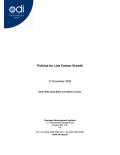IISD and the Partnership for Procurement and Green Growth conducted an investigation to explore the correlation between public procurement and the tipping point at which it serves as a trigger for green industrial innovation, expansion and growth. Building on the existing body of work that supports the case for green public procurement, the report demonstrates that procurement is becoming more than just a purchasing tool, but is increasingly positioned as an economic driver, an incentive for green innovation and green industrialisation, a support for small and medium enterprise (SME) competitiveness and much more.
Environmental information transparency performs social and learning functions indispensable for green growth. Still facing the challenges of a lack of local commitment and less than optimal institutional capacity, China has made substantial progress on granting and enforcing the public right to environmental information. This will help build the social infrastructure necessary for green growth — the rule of law, trust, social organizing, consensus building, social learning, and collective action. A focused approach is desirable because resources and capacity are limited in China — targeting pollutants and sectors that exert the most environmental and health risks as well as those that need technological upgrade most urgently. Then, in the long run, environmental information transparency serves the fundamental goals of ‘good public policy and legitimate governmental decision-making’ on environment-related issues in China, in line with both the green growth framework and the long-term development goal of constructing a harmonious society in China.
What kind of clean-energy support measures can be maintained under international trade rules and what cannot? Policy certainty reflected within a clear and coherent trade and energy governance regime is critical for boosting investor confidence and fostering clean energy investments. Ambiguity on clean energy support measures within WTO rules could cast a chilling effect on domestic efforts to scale up sustainable energy. One way of dispelling such ambiguity is through a possible sustainable energy trade agreement (SETA). This paper emphasises the importance of understanding what are the types of clean energy subsidies countries usually provide, why countries provide them, and how they fit into existing legal mechanisms. A SETA, by simultaneously addressing these questions and clarifying existing WTO subsidy rules, would add to the certainty and predictability of a country’s trade and investment climate.

Written by the research team of at the Institute for Labor Studies, Ministry of Human Resources and Social Security, China, this study presents both the current situation and potential for green employment in China, as well as results of surveys conducted in eight companies in the power industry. In China, green employment can be defined as work in industries, sectors, enterprises, and positions which have low input, high output, low consumption, low emissions, recyclability and sustainability. The purpose of the study is to make policy recommendations for China’s transition toward green employment.
